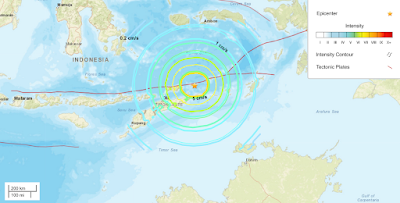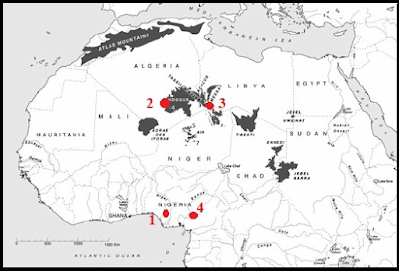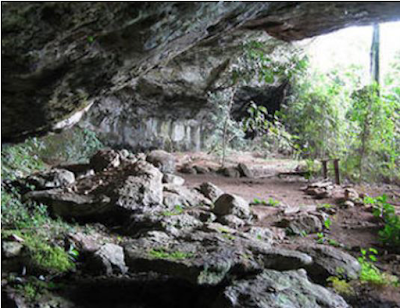The organised disposal of the dead is considered to be an important step in the development of Human cognition, an activity driven by the needs of the living to cope with the loss of a loved one, rather than any need of the deceased. In Africa, the earliest burials appear about 90 000 years ago, and are generally of single people thought to have been buried by nomadic or semi-nomadic peoples, with notable examples at Taramsa I in Egypt (about 55 000 years old), Shum Laka in Cameroon (7100-6900 and 3300-3000 years old), Mbi-Crater, also in Cameroon (about 7790 years old), Wadi Kubbaniya in Egypt 19 000-17 000 years old), Amekni in Algeria (9000-8000 years old), Ti-n-Hanakaten, also in Algeria (about 6000 years old), and Iwo Eleru in Nigeria (16 000-11 000 years old). These are eventually replaced by the emergence of formal cemeteries, about 25 000-23 000 years ago, in which the dead are buried together at sites dedicated to the purpose, thought to be a sign of people living together in settled communities, with notable examples at Mechta el Arbi in Algeria (22 000-13 000 years old), Afalou Bou Rhummel, also in Algeria (12 450-10 500 years old), Columnata, again in Algeria (8300-7300 years old), Taforalt in Morocco (15 100-14 000 years old), and in northern Sudan (14 340-13 140 years old).
In a paper published in the Journal of Anthropological And Archaeological Sciences on 20 December 2021, Augustin Holl of the Department of Anthropology and Ethnology at Xiamen University explores the Iwo Eleru, Amekni, Ti-n-Hanakaten, and Shum Laka burial sites, and what these can tell us about the people buried there, and the people who buried them.
Location of the sites discussed. (1) Iwu Eleru. (2) Amekni. (3) Ti-n-Hanakaten. (4) Shum Laka. Holl (2021).
The Iwo Eleru Rock Shelter in southwestern Nigeria (modern Ondo State). The site was first excavated in the 1960s by a team led by Thurstan Shaw, revealing a Human skeleton in a tightly crouched position between two large collapsed stone slabs. The skeleton was poorly preserved, but is thought to have been a man between 35 and 45 years of age at the time of death. The teeth of Iwu Eleru Man were very badly worn, ground down to the gums in a series of great sweeping oblique curves running in different directions. Damage of this kind can be caused by certain forms of craft-working, notably basket or Reed-mat making, or by eating extremely fibrous foods, such as raw and sometime sandy fibrous tropical tubers. The body was covered by about 1.5 m of sediment, containing numerous lithic artefacts, notably quartz and chalcedony segments, borers, scrapers, trapezes, trapezoïds, points, and truncated blades. Towards the top of this sequence pottery fragments and ground stone axes appear, although there are no obvious stratigraphic breaks in these deposits.
The deposits above the burial indicate that the site continued to be used by living Humans after the burial, although probably not continuously. The site is likely to have been repeatedly used as a shelter by non-settled peoples passing through the area, perhaps seasonally, with the burial being placed there because a member of the community died while they were staying there. No grave goods were found, but the body was covered over by two large stone slabs, and possibly leaves, twigs, and tree branches, which implies some form of ritual, and a desire to protect the body from scavenging by wild Animals.
View of Iwo Eleru rock-shelter. Holl (2021).
The Amekni burial is in a granite boulder field to the southwest of the Ahaggar Mountains of southern Algeria. The area is known to have been inhabited by pottery-making foragers between 7000 and 6000 BC, and these are thought to be the people responsible for the burial. Three skeletons were found at this site, a woman thought to be 40-50 years old, and two children aged roughly 2-3 and 5-6, who were buried in a crouched position, and possibly wrapped in Animal skins. The woman is probably two old to have been the children's mother, though she could possibly have been their grandmother. This does not appear to have been the beginnings of an organised cemetery, but rather the burial of three members of a mobile community, and possibly the same family, who died at approximately the same time and were therefore buried in the same place.
The Ti-n-Hanakaten rock shelter is located at the junction of the Tadrart Acacus and Tassili-n-Ajjer mountains, about 150 km to the southeast of the town of Djanet. The site has a Epipalaeolithic archaeological sequence about 5 m thick, which spans about 20 000 years and records the advent of pottery in the area, as well as a scattering of Acheulean artefacts (an Old Stone Age technology, associated with Homo erectus rather than Modern Humans). The site produced a single burial, a child of uncertain age, who was buried in a tightly crouched position, wrapped in an Animal skin, within a circular pit filled with grass and straw, and sealed with a large stone slab, which had been smeared with red ochre. The Ti-n-Hanakaten burial has been dated to about 6000 years old, making it a similar age to the Amekni burial, with which it shares some similarities; in both cases children were buried in crouched positions and wrapped in Animal skins. However, the Ti-n-Hanakaten burial is more elaborate than the Amekni burial.
The Shum Laka rock-shelter is located in the volcanic highlands of northwestern Cameroon, at an altitude of 1600 m above sealevel, overlooking the Laka Valley. The rockshelter is located at the foot of a waterfall, and measures roughly 54 m by 25 m, with a floor surface of about 1181 m², of which 82 m² has been excavated, and an 8 m high roof.
The site has yielded four distinct archaeological units, ranging in age from 32 000 to 3000 years. There are two sets of burials here, both associated with Holocene layers, the older dating from 7100-6900 years ago with four sets of remains in three burial and the younger from 3300-3000 years ago with fourteen sets of remains in nine burials. This larger clustering of burials raises the possibility that the people here might have been moving towards the organised burial of their dead in permanent cemeteries set aside for this purpose.
View of Shum-Laka rock-shelter. Holl (2021).
The earlier phase contains three burials at the northwest of the excavated area. The first of these is a man of about thirty with moderate osteophytosis on some vertebrae, some inflammation of the limbs, and two healed fractures, on the clavicle and left humerus, as well as dental calculus and heavy wear to the canine teeth, something which is almost certainly associated with some form of craftwork. His death appears to have been due to the cumulative effects of illness and old age, and his remains have been dated to about 7040 years ago. He was buried bout 8 m from the entrance to the cave, laid on the bedrock and covered with stones (in a similar fashion to the Iwu Elero burial), and covered by about 80 cm of sediment. The skeleton was in a sleeping position on its right side, with hands under the head, fcing towards the entrance of the shelter.
The second early phase burial is locater 3 m south of the first, and 5 m from the entrance. It contains two sets of remains, a boy of about four years and a subadult about 15 years old, of indeterminate sex, with the child buried on top of the subadult, at the same time, in a pit surrounded by and filled with stones.
The boy has Harris lines on his bones, suggesting periods of arrested growth in his development, possibly indicating he was suffering from an infectious disease before his death. He was buried on his left side in a tightly contracted position, with his knees under his chin, facing towards the north, under about 65-95 cm of sediment, and his remains have been dated to approximately 7150 years ago.
The second skeleton has signs of an injury to the lower jaw, which caused a number of dental deformities, which possibly occurred when they were six or seven years old, as well as signs of an old injury to the left foot, which led to localised vascular disturbance. In addition to the injuries the skeleton had a hypertrophy of the supinator crest, which is an indication of regular practice with a throwing implement, such as a spear. The remains were buried in a half flexed half stretched position, the left arm stretched, the right one folded at right angle, and, like the younger child's, have been dated to 7150 years ago.
The final early stage grave appears to be a secondary grave for someone who was initially buried somewhere else. This contains a selection of limb bones, namely a right and left femur, right radius, and right fibula, all apparently from an 18-year-old male, 1.64 – 1.66 m tall. These were buried in a pit 60 cm deep, 75 cm long, and 25 cm wide, into which some Animal bones had also been deposited, although it is unclear if this association was deliberate. This individual appears to have been suffering from an unhealed ankle injury at the time of death, but was otherwise physically fit, with muscle attachments which suggest a powerful physique, and again regular practice with a spear or similar implement. These remains have been dated to 6870 years ago.
The wide range of dates obtained for these burials combined with the differences in burial style strongly suggest this was not a sign of a developing cemetery, but rather of a series of separate burials by different groups of people who moved through the area, and used the shelter temporarily, burying members of their groups who died while they were there.
Early and Late Holocene burial clusters from Shum Laka. Holl (2021).
The second group of burials are dated to between 3300 and 3000 years ago, and comprise fourteen sets of remains in nine separate burials, located at the eastern end of the excavated area.
The first of these burials is a girl of about eight years old. The teeth of this girl suggest a series of severe health crises throughout her life beginning when she was about 6-9 months old, and continuing throughout her life. She was buried in a flexed position on her left side, facing to the north, about 7 m from the cave entrance and 25 cm deep. Her remains have been dated to about 3045 years ago.
The second of the younger phase burials is another young child, this time about four years old, and probably a girl. This individual seems to have been healthier than the first until the time of death, with some dental calculus, but no other pathologies. The body was laid on its back in a pit less than a meter from the previously described burial, and 4-5 m from the cave entrance. These remains have also been dated to about 3045 years ago.
The third of the younger phase burials contains two sets of remains, both those of adult women. This grave was placed 5 m from the rock shelter entrance, and was about 75-95 cm deep. They were placed on their sides, back-to-back, with the first woman facing to the west and the second to the east. Both sets of remains have been dated to 3300 years ago.
The first of these women was 20-30 years old and about 1.53-1.55 m tall at her time of death. She had several dental pathologies which suggest several episodes of illness or malnutrition in her childhood, with muscle attachments that suggest she was physically strong and regularly took part in repetitive physical activity.
The second woman is estimated to have been 30-50 years old at her time of death, and 1.43-1.48 m tall. Unlike the first woman, she appeared to be suffering from a number of health problems, including severe dental decay and Arthritis of the spine and lower arms, which appear to have related to her age and a lifestyle involving frequent hard labour. Despite this, she also appears to have been well muscled, and from the asymmetry of her muscle attachments, probably right handed.
The joint burial of two women from the younger burial phase at Shum Laka. Lipson et al. (2020).
The fourth burial of the new phase is located about 1.5 m to the north of the first, and contains 273 skeletal elements, derived from at least seven children, placed in a pit 1 m long, 60 cm wide, and 45 cm deep. This pit appears to contain a mixture of primary and secondary burials, with some of the remains showing signs of heating. The two primary internments are a boy of 5-7 years old showing signs of repeated environmental stresses in his life, and a stone arrowhead stuck in his left ilium, which appears to have been the cause of death, and another child of 10-16 years old. The remaining bones are from disarticulated skeletons, presumed to be secondary burials. These include three children aged 2-4 years, a 3-5 year old, and a 5-9 year old, most of which show pathologies that would have related to health problems in life.
This grave is confusing, and difficult to interpret, but Holl notes that there appear to have been two phases of burial within the same pit, with the two children identified as primary burials interned together, between 3180 and 3025 years ago, and the disarticulated and possibly cremated remains (which could not be dated) added later, possibly accidentaly uncovering the earlier grave in the process.
Burial Unit 7 (collective) showing disarticulated crania and one partially articulated post-cranial skeleton (20-30 cm below surface). Lipson et al. (2020).
The fifth of the new phase burials contains the remains of two robust adult males, aged 30-35 and 40-45 years. These remains had been cremated prior to burial, and was disarticulated and separated into three piles, the first containing cranial vault and tibia fragments, the second long bones and cranial vault fragments, and the third long bones and mandibulae fragments. These remains could not be dated, but appear to predate the third new phase burial, which overlies and partially disturbs this burial; this is a reversal of the situation in the fourth new phase burial, in which the deposition of cremated remains appears to have disturbed un-cremated remains which were buried earlier.
The final new phase burial is another set of cremated remains, this time of a single individual. In this case a high temperature appears to have been achieved during the cremation (probably about 800°C) resulting in very white and fragmentary remains, although parts of the skull, teeth, vertebrae, ribs, scapulae and clavicles, hands, sacrum, coccyx, and coxal bones, long bones, feet, and undetermined long bones could be identified, supporting the hypothesis that this was a single, intact, individual. These remains could not be dated, but again they appear to have pre-dated and been partially disturbed by, the third new-phase burial.
Although these burials represent a reasonably high number of individuals in a moderately short period of time (14 individuals in about 300 years), the differences in the ways in which they were buried, combined with the fact that some of the burials appeared to have accidentally disturbed older burials, suggests that this was still not a site being used specifically as a cemetery, but rather repeatedly chosen as a burial site by different groups of people moving through the area, and probably using the rock shelter as a temporary dwelling place.
See also...





Follow Sciency Thoughts on Facebook.
Follow Sciency Thoughts on Twitter.




























